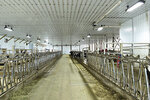

ROGERS, Minn. – Quinci Scherber went to college with intentions of operating her family’s dairy farm someday, and with her parents’ foresight for the farm’s long-term viability, the young dairywoman is accomplishing just that.
[[In-content Ad]]
“There are different ways of farming that works for each family with the land availability, systems and routines dictating a lot of it,” Scherber said. “I’ve always wanted to dairy farm, and robots allow me to do that but also focus on my other dreams. Sure, it comes with challenges but, for us, robots were the way to go.”
Scherber and her parents – John and Staci – milk 110 cows with two Lely A5 robotic milking systems on their dairy farm in Hennepin County near Rogers. Cows first went through the robots July 13, 2021.
The milking robots are the family’s latest investment to modernize their dairy.
Prior to installing the system, they built the freestall barn and incorporated an automated feeding system in 2016. In the interim, the Scherbers housed their herd in the freestall barn and milked them in the farm’s original 46-stall tiestall barn every 10 hours.
“It took us a long time to build this barn and put in the robots, but my dad really wanted everything right,” Scherber said. “He envisioned this farm for the future and how it could stay a family farm here. I got pretty lucky with the dad I have.”
The freestall barn sits 118 feet wide and 192 feet long, with only a 12-foot feed alley. Each stalled pen contains automatic alley scrapers.
On the south side of the barn, the milking herd is housed in one pen, with a special needs pen to the west of one robot room. The special needs pen is strategically placed for cows to enter a robot and circle back into their pen, Scherber said.
Across the feed alley are three pens for dry and fresh cows – far-off, close-up and a maternity area.
After calving, cows are kept in the maternity pen for eight hours post-calving for monitoring. Then, they are moved to the special needs pen where they can use the robot but are withheld from the lactating herd. Within two days post-calving, the cows enter the lactating pen.
The free-flow barn design and incorporation of automated milking fit the vision for the Scherbers.
“Dad was not ready to retire, but with expanding our cow numbers, milkings became much longer and a change was necessary,” Scherber said. “Plus, we wanted to keep this a small family farm and include me in the picture. We couldn’t expand physically with the land we are on, so robots helped us support our dream.”
After installing the automated feeding system, and being satisfied with both its function and the technical support, the Scherbers knew which system they wanted to implement for their milking robots.
While the Scherbers and their herd had time to become accustomed to the freestall barn and automated feeding system, transitioning to automated milking came with unanticipated challenges.
They completed milking in the tiestall barn at 3 a.m. July 13, 2021, and by noon that day, the cows were guided through the robots. However, rather than entering the robots, the cows would gather at the side door of the barn at milking times waiting to be milked in the old tiestall barn.
“It was quite the transition,” Scherber said. “We trained the herd for two weeks 24/7, and the cows just took a little while to change their routine. We could not have done it without all the help we received from family, friends and those from the company.”
A month into the new setup, the cows became familiar with the robots and they started to get the idea. Then, they seemed to use the robots more freely.
“We had great help and it was appreciated; the process seemed overwhelming but we were taken care of,” Scherber said. “After that first few weeks, things quieted down, and the cows became more comfortable in their new environment.”
Over the course of the first year with the new technology, the cows developed routines. The heifers, too, transition easily as they have opportunity to walk through the robot prior to calving.
The Scherbers have gone from fetching an average of 20 cows daily to zero.
“They’re really getting the hang of it,” Scherber said. “It’s a relief that this is a calm process, and I think everyone benefits, us and the cows.”
On average, the herd goes through the robots 3.2 times a day. Milk production has been greater than ever before, and Scherber anticipates that to further increase as the barn is filled to its capacity at 120 cows. Additionally, the farm’s breeding program has completely changed for the better as activity monitors collect data on each cow and the Scherbers have time to make appropriate decisions for each animal.
The robots have also allowed the Scherbers to focus on putting up better quality forages by not having to delay harvest for milking which has resulted in better cow health.
“These robots have benefitted us so we can do the work that benefits the cows,” Scherber said. “We love them and it’s been a great addition to the farm. I’d never go back to milking how we were.”
The original tiestall barn is being retrofitted into a youngstock facility with automated calf feeders.
Scherber graduated from the University of Wisconsin-River Falls with degrees in dairy management and food science. She hopes to one day incorporate an on-farm creamery into her family’s operation where she can make and sell homestead ice cream for the metropolitan area.
The soon-to-be married woman also wants to raise a family on the farm.
Automation will help Scherber achieve all of that.
“Dairy farming is our lifestyle and it means so much to us,” Scherber said. “Now, we can still do that and have other dreams too.”
Comments
No comments on this item Please log in to comment by clicking here